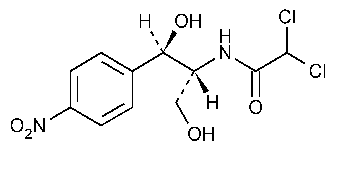Chloramphenicol
Acetamide,2,2-dichloro-N-[2-hydroxy-1-(hydroxymethyl)-2-(4-nitrophenyl)ethyl]-,[R-(R*,R*)]-.
D-threo-(-)-2,2-Dichloro-N-[b-hydroxy-a-(hydroxymethyl)-p-nitrophenethyl]acetamide [56-75-7].
»Chloramphenicol contains not less than 97.0percent and not more than 103.0percent of C11H12Cl2N2O5.
Packaging and storage—
Preserve in tight containers.
Labeling—
Where it is intended for use in preparing injectable or other sterile dosage forms,the label states that it is sterile or must be subjected to further processing during the preparation of injectable or other sterile dosage forms.
Identification—
A:
Infrared Absorption á197Kñ.
B:
The retention time of the major peak in the chromatogram of the Assay preparationcorresponds to that in the chromatogram of the Standard preparationas obtained in the Assay.
Specific rotation á781Sñ:
between +17.0 and +20.0
and +20.0 .
.
Test solution:
50mg,undried,per mL,in dehydrated alcohol.
Crystallinity á695ñ:
meets the requirements.
Bacterial endotoxins á85ñ—
Where Chloramphenicol is intended for use in preparing injectable dosage forms,it contains not more than 0.2USP Endotoxin Unit per mg of chloramphenicol.
Sterility á71ñ—
Where the label states that Chloramphenicol is sterile,it meets the requirements when tested as directed for Membrane Filtrationunder Test for Sterility of the Product to be Examined,except to use 1g of solid specimen.
pHá791ñ:
between 4.5and 7.5,in an aqueous suspension containing 25mg per mL.
Chromatographic purity—
Dissolve an accurately weighed quantity of Chloramphenicol in methanol to obtain a test solution containing 10mg per mL.Prepare a solution of USP Chloramphenicol RSin methanol containing 10mg per mL(Standard solution A).Dilute portions of Standard solution Aquantitatively with methanol to obtain Standard solution Bcontaining 100µg per mLand Standard solution Ccontaining 50µg per mL.Apply separate 20-µLportions of the test solution and Standard solutions Band Cto a suitable thin-layer chromatographic plate (see Chromatography á621ñ),coated with a 0.25-mm layer of chromatographic silica gel mixture.Develop the chromatogram in a solvent system consisting of a mixture of chloroform,methanol,and glacial acetic acid (79:14:7)until the solvent front has moved about three-fourths of the length of the plate.Remove the plate from the chamber,air-dry,and examine under short-wavelength UVlight:any spot other than the principal spot obtained from the test solution does not exceed in size or intensity the principal spot obtained from Standard solution B(1%),and the sum of the impurities represented by all of the spots other than the principal spot,based on a comparison of the intensities of such spots with the intensities of the principal spots obtained from Standard solutions Band C,does not exceed 2%.
Assay—
Mobile phase—
Prepare a suitable filtered mixture of water,methanol,and glacial acetic acid (55:45:0.1).Make adjustments if necessary (see System Suitabilityunder Chromatography á621ñ).
Standard preparation—
Dissolve an accurately weighed quantity of USP Chloramphenicol RSin Mobile phase,and dilute quantitatively,and stepwise if necessary,with Mobile phaseto obtain a solution having a known concentration of about 80µg per mL.Filter a portion of this solution through a 0.5-µm or finer porosity filter,and use the clear filtrate as the Standard preparation.
Assay preparation—
Transfer about 200mg of Chloramphenicol,accurately weighed,to a 100-mLvolumetric flask,add Mobile phaseto volume,and mix.Transfer 4.0mLof the resulting solution to a 100-mLvolumetric flask,dilute with Mobile phaseto volume,and mix.Filter a portion of this solution through a 0.5-µm or finer porosity filter,and use the clear filtrate as the Assay preparation.
Chromatographic system
(see Chromatography á621ñ)—The liquid chromatograph is equipped with a 280-nm detector and a 4.6-mm ×10-cm column that contains 5-µm packing L1.The flow rate is about 1mLper minute.Chromatograph the Standard preparation,and record the peak responses as directed under Procedure:the column efficiency determined from the analyte peak is not less than 1800theoretical plates,the tailing factor is not more than 2.0,and the relative standard deviation for replicate injections is not more than 1.0%.
Procedure—
[NOTE—Use peak heights where peak responses are indicated.]Separately inject equal volumes (about 10µL)of the Standard preparationand the Assay preparationinto the chromatograph,record the chromatograms,and measure the responses for the major peaks.Calculate the quantity,in mg,of C11H12Cl2N2O5in the portion of Chloramphenicol taken by the formula:
2.5C(rU/rS),
in which Cis the concentration,in µg per mL,of USP Chloramphenicol RSin the Standard preparation,and rUand rSare the peak responses obtained from the Assay preparationand the Standard preparation,respectively.
Auxiliary Information—
Staff Liaison:William W.Wright,Ph.D.,Scientific Fellow
Expert Committee:(PA7)Pharmaceutical Analysis 7
USP28–NF23Page 427
Phone Number:1-301-816-8335
